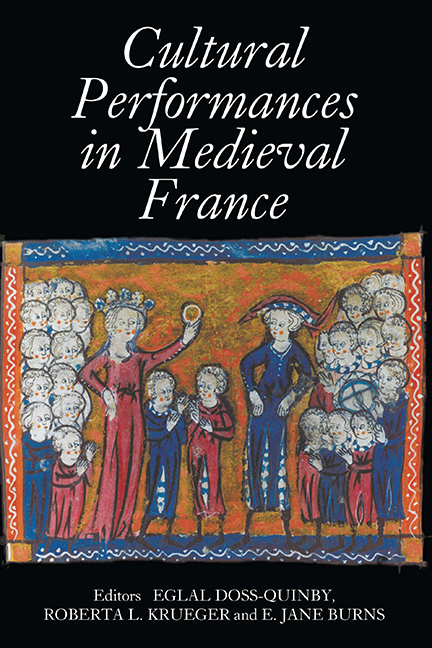Book contents
- Frontmatter
- Contents
- List of Illustrations
- Contributors
- Introduction
- Nancy Freeman Regalado, Curriculum Vitae
- PART I POETIC AND MUSICAL PERFORMANCES
- PART II PERFORMING SEXUAL AND SOCIAL IDENTITIES
- Intimate Performance: An Ivory Writing Tablet Cover at The Cloisters
- A Cultural Performance in Silk: Sebelinne's aumousniere in the Dit de l'Empereur Constant
- Acting Like a Man: Performing Gender in Tristan de Nanteuil
- Amorous Performances: The Aventure de l'espee vermeille in Perceforest
- Historicizing Performance: The Case of the Jeu de Robin et Marion
- The Protean Performer: Defining Minstrel Identity in Tristan Narratives
- PART III DEVOTIONAL PRACTICE AND TEXTUAL PERFORMANCE
- PART IV PERSUASIVE PERFORMANCES
- PART V RE–ENACTMENTS AND LEGACIES
- Tabula Gratulatoria
- Tabula Gratulatoria
A Cultural Performance in Silk: Sebelinne's aumousniere in the Dit de l'Empereur Constant
from PART II - PERFORMING SEXUAL AND SOCIAL IDENTITIES
Published online by Cambridge University Press: 24 October 2017
- Frontmatter
- Contents
- List of Illustrations
- Contributors
- Introduction
- Nancy Freeman Regalado, Curriculum Vitae
- PART I POETIC AND MUSICAL PERFORMANCES
- PART II PERFORMING SEXUAL AND SOCIAL IDENTITIES
- Intimate Performance: An Ivory Writing Tablet Cover at The Cloisters
- A Cultural Performance in Silk: Sebelinne's aumousniere in the Dit de l'Empereur Constant
- Acting Like a Man: Performing Gender in Tristan de Nanteuil
- Amorous Performances: The Aventure de l'espee vermeille in Perceforest
- Historicizing Performance: The Case of the Jeu de Robin et Marion
- The Protean Performer: Defining Minstrel Identity in Tristan Narratives
- PART III DEVOTIONAL PRACTICE AND TEXTUAL PERFORMANCE
- PART IV PERSUASIVE PERFORMANCES
- PART V RE–ENACTMENTS AND LEGACIES
- Tabula Gratulatoria
- Tabula Gratulatoria
Summary
If all of Proust's world comes out of a teacup, the world of Sebelinne, a littleknown heroine in the Old French Dit de l'Empereur Constant, comes out of a silk purse. Indeed this thirteenth-century Byzantine romance about religious conversion and male dynastic succession actually turns on a small object fashioned from cloth: a richly decorated, heavily embroidered aumousniere. Whether damask or velvet, decorated with silk or gold embroidery, Old French aumousnieres described in romance texts and trade accounts of the thirteenth century are fashioned typically from costly silk and hung from a belt, itself often made of rich silk fabric. Although the name aumousniere suggests a pouch that might hold alms for the poor or money to be donated at pilgrimage shrines, many literary texts feature silk purses as practical receptacles for small change, herbs, unguents, and medicines, or as decorative items of attire holding anything from rings, keys, and jewels to relics and even sewing supplies. Used at times to carry holy bread, aumousnieres could also become highly symbolic gifts given as love tokens. Most interestingly, however, we know from guild accounts that silk aumonières were produced in thirteenth-century Paris and that they included a category termed “aumosnieres sarrasinoises,” purses fashioned in the manner of highly decorated Saracen work on imported silk cloth or copies thereof. The very combination of the terms “aumosnieres” and “sarrasinoises” generates a network of rich cultural resonances that are staged in the Dit de l'Empereur Constant through a dynamic and interactive performance between an unprepossessing heroine and a small piece of silk. Atypically, the aumousniere in this text contains not a relic, ring or coin but a sequence of hand-written messages. Indeed, this ornate purse is perhaps most significant as a material object from which the heroine scripts and fashions a brief plot of monumental proportions. Deftly manipulating a culturally charged item of silk, she executes a remarkable cultural performance. I would like to analyze that performance here in honor of Nancy Regalado's extended scholarly commitment to broadening our understanding of medieval performances in many guises.
A Conversion Story?
The Empereur Constant recounts no less than the legendary transformation of Byzantium into Constantinople, ostensibly by a lowly youth, Constant, who is himself changed unpredictably in the course of the tale from a “fils de vilain” into a worthy nobleman.
- Type
- Chapter
- Information
- Cultural Performances in Medieval FranceEssays in Honor of Nancy Freeman Regalado, pp. 71 - 78Publisher: Boydell & BrewerPrint publication year: 2007

